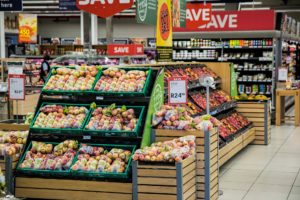47.8 Million Cases of Foodborne Illness to be Solved by Technology
The CDC estimates that 47.8 million cases of foodborne illness occur each year. Food traceability systems, powered by blockchain technology, offer a promising solution.
What is Food Traceability?
 Food traceability is the use of tracking mechanisms to verify and communicate vital information concerning food products to provide the consumer with accurate information, mitigate the risk of foodborne illnesses, and keep contaminated food from spreading into an outbreak. Blockchain-based technology powers food traceability systems by constructing a tamper-proof, verifiable way to track the following pertinent food-related data:Origin – the farm and processing center that the food product came fromToxins & Pathogens – testing for the presence of potentially harmful substances in contact with the food productChemicals – the fertilizers, pesticides, growth hormones, antibiotics, and other chemicals that directly or indirectly come in contact with the food productsOrganic Status – whether or not the food product qualifies as organic based on the product’s origin and lack of contact with certain chemicalsSocial Issues – the conditions under which consumable animals are housed and whether or not they are humanely treated; this may include labels such as cage-free eggs, free-range cows, etc.Harvest Date – the date the food product was harvested or, in the case of consumable animals, the date that the animal was slaughteredTemperature – the temperature that the food product has been kept at since the harvest date; certain food products are required to be held in a specific temperature range to prevent spoilageHumidity – the humidity levels of the food product since the harvest date; certain food products are required to be stored between particular humidity levels to avoid spoilage and the development of bacteriaSell By Date – the date that the food product should be sold byExpiration Date – the date that the food product should be discarded
Food traceability is the use of tracking mechanisms to verify and communicate vital information concerning food products to provide the consumer with accurate information, mitigate the risk of foodborne illnesses, and keep contaminated food from spreading into an outbreak. Blockchain-based technology powers food traceability systems by constructing a tamper-proof, verifiable way to track the following pertinent food-related data:Origin – the farm and processing center that the food product came fromToxins & Pathogens – testing for the presence of potentially harmful substances in contact with the food productChemicals – the fertilizers, pesticides, growth hormones, antibiotics, and other chemicals that directly or indirectly come in contact with the food productsOrganic Status – whether or not the food product qualifies as organic based on the product’s origin and lack of contact with certain chemicalsSocial Issues – the conditions under which consumable animals are housed and whether or not they are humanely treated; this may include labels such as cage-free eggs, free-range cows, etc.Harvest Date – the date the food product was harvested or, in the case of consumable animals, the date that the animal was slaughteredTemperature – the temperature that the food product has been kept at since the harvest date; certain food products are required to be held in a specific temperature range to prevent spoilageHumidity – the humidity levels of the food product since the harvest date; certain food products are required to be stored between particular humidity levels to avoid spoilage and the development of bacteriaSell By Date – the date that the food product should be sold byExpiration Date – the date that the food product should be discarded
Why is Blockchain a Game-Changer in Food Traceability?
As previously noted, the blockchain is a tamper-proof and verifiable. The fact blockchain is tamper-proof prevents unauthorized changes of food-related data. For example, temperature data is stored on the blockchain and cannot be altered. If the temperature ever fell below or rose above the safety range for a period of time, this fact will be reflected in the food product’s traceability report. Both retailers and consumers will have access to the temperature data. It is impossible for the supplier, distributor or retailer to alter the temperature data. Because the information stored on the blockchain is verifiable, consumers trust that the food product never fell below or rose above the safety range. Because tamper-proof and verifiable food-related data is accessible by the retailer and the consumer, food traceability promotes a culture of greater transparency and accountability.
What are the Three Goals of Food Traceability?
Retailers are launching blockchain-based food traceability systems to achieve the following goals:Provide Customers with Accurate Information – Consumer demand plays a significant role in the emergence of food traceability systems. Not only do customers expect that the food they consume is safe, but there is also an overwhelming demand for organic and ethically-sourced goods. Customers have proven that they are willing to pay more for a product that they believe is organic or ethically-sourced. Retailers who promote their food products as blockchain-certified will have a competitive advantage over retailers who keep their customers in the dark. It won’t be long before consumers can scan the barcode on products and view the pertinent food-related data for that specific item. Food traceability will inevitably promote customer confidence and increase customer retention.Mitigate the Risk of Foodborne Illnesses – According to the Center for Disease Control (CDC) in the United States, it is estimated that there are 47.8 million cases of foodborne illnesses each year (https://www.cdc.gov/foodborneburden/2011-foodborne-estimates.html). Restitution resulting from foodborne illnesses costs retailers millions of dollars per year. Retailers also take a loss when they have to pull potentially contaminated food products off their shelves. Food traceability is designed to mitigate the risk of foodborne illnesses and reduce unnecessary costs by catching spoiled products before they reach the shelves. For example, if the temperature of raw chicken breasts drops below 4°C for more than a couple of hours, it can begin to grow bacteria. If the chicken is kept at 4°C for more than 24 – 48 hours, it can also start to grow bacteria. Since a blockchain-based system keeps track of the temperature and the harvest date, retailers can discard any chicken breasts that were not stored properly.Contain Outbreaks and Prevent the Spread of Disease – Although several precautions are being taken to prevent the spread of food-related diseases, cases can still occur. When they do occur, a blockchain-based system can contain an outbreak and prevent the disease from spreading any further. Because food traceability systems keep track of the originating farm, processing center, and distribution routes, it can quickly pinpoint the contaminated products. Retailers can pull contaminated food-items off the shelves immediately, potentially saving a life.Getting Started with Food Traceability SystemsThe NeuroChain protocol is being designed to host a range of interoperable applications in the supply chain management industry. To find out more about getting started with food traceability systems in your business.
NeuroChain, let’s build a better world!
Photo credits: PixabayFollow us on Telegram, Facebook, Twitter and YouTube. If you have any questions, feel free to get in touch with NeuroChain Team, and we will answer you as soon as possible!
